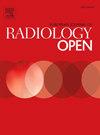利用多序列乳腺磁共振成像融合放射组学和深度学习模型对乳腺良性和恶性病变进行分类的研究
IF 2.9
Q3 RADIOLOGY, NUCLEAR MEDICINE & MEDICAL IMAGING
引用次数: 0
摘要
目的开发一种结合多序列乳腺核磁共振成像融合放射组学和深度学习的多模态模型,用于乳腺良性和恶性病变的分类,以帮助临床医生更好地选择治疗方案。这些患者按 7:1:2 的比例随机分为训练集、验证集和测试集。随后,使用卷积神经网络 ResNet50 提取 T1 加权图像(T1WI)、T2 加权图像(T2WI)和动态对比增强 MRI(DCE-MRI)的特征进行融合,然后将这三种序列的放射学特征结合起来。建立了以下模型:T1 模型、T2 模型、DCE 模型、DCE_T1_T2 模型和 DCE_T1_T2_rad 模型。通过接收者操作特征曲线(ROC)下面积(AUC)、准确性、灵敏度、特异性、阳性预测值和阴性预测值来评估这些模型的性能。本研究建立的五个模型表现良好,T1 模型的 AUC 值为 0.53,T2 模型为 0.62,DCE 模型为 0.79,DCE_T1_T2 模型为 0.94,DCE_T1_T2_rad 模型为 0.98。与其他四个模型相比,DCE_T1_T2_rad 模型的差异具有统计学意义(P < 0.05)。本文章由计算机程序翻译,如有差异,请以英文原文为准。
Study on the classification of benign and malignant breast lesions using a multi-sequence breast MRI fusion radiomics and deep learning model
Purpose
To develop a multi-modal model combining multi-sequence breast MRI fusion radiomics and deep learning for the classification of benign and malignant breast lesions, to assist clinicians in better selecting treatment plans.
Methods
A total of 314 patients who underwent breast MRI examinations were included. They were randomly divided into training, validation, and test sets in a ratio of 7:1:2. Subsequently, features of T1-weighted images (T1WI), T2-weighted images (T2WI), and dynamic contrast-enhanced MRI (DCE-MRI) were extracted using the convolutional neural network ResNet50 for fusion, and then combined with radiomic features from the three sequences. The following models were established: T1 model, T2 model, DCE model, DCE_T1_T2 model, and DCE_T1_T2_rad model. The performance of the models was evaluated by the area under the receiver operating characteristic (ROC) curve (AUC), accuracy, sensitivity, specificity, positive predictive value, and negative predictive value. The differences between the DCE_T1_T2_rad model and the other four models were compared using the Delong test, with a P-value < 0.05 considered statistically significant.
Results
The five models established in this study performed well, with AUC values of 0.53 for the T1 model, 0.62 for the T2 model, 0.79 for the DCE model, 0.94 for the DCE_T1_T2 model, and 0.98 for the DCE_T1_T2_rad model. The DCE_T1_T2_rad model showed statistically significant differences (P < 0.05) compared to the other four models.
Conclusion
The use of a multi-modal model combining multi-sequence breast MRI fusion radiomics and deep learning can effectively improve the diagnostic performance of breast lesion classification.
求助全文
通过发布文献求助,成功后即可免费获取论文全文。
去求助
来源期刊

European Journal of Radiology Open
Medicine-Radiology, Nuclear Medicine and Imaging
CiteScore
4.10
自引率
5.00%
发文量
55
审稿时长
51 days
 求助内容:
求助内容: 应助结果提醒方式:
应助结果提醒方式:


